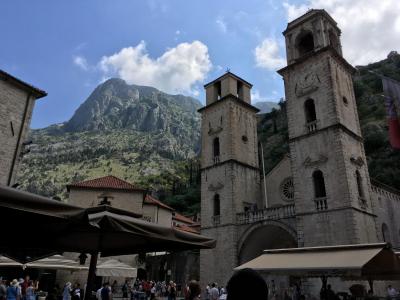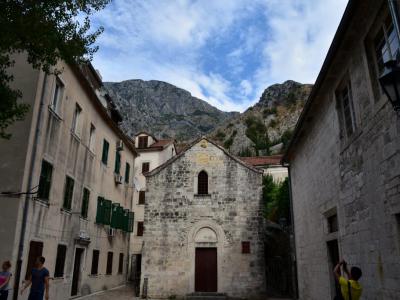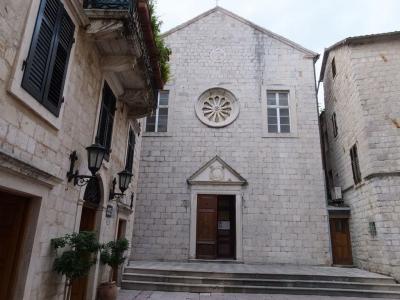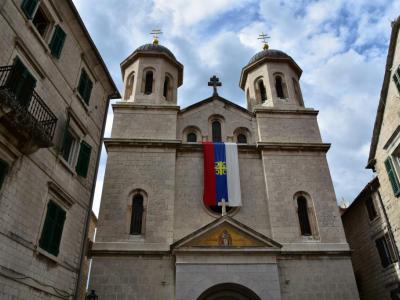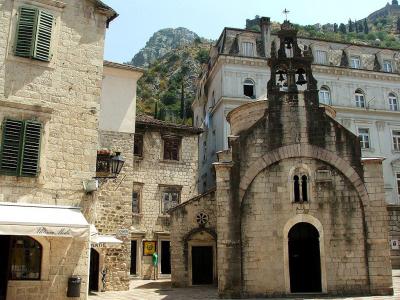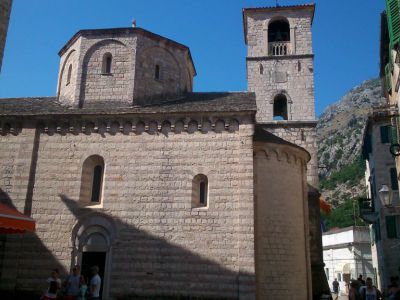
Kotor's Historical Churches Walking Tour (Self Guided), Kotor
Kotor, a picturesque coastal town in Montenegro, albeit small, nonetheless, boasts a surprising number of historical churches that beautifully reflect its centuries-old heritage. Many of these temples are richly decorated with frescoes, some dating as far back as the 1300s.
At the heart of the town lies Saint Tryphon Square dominated by the eponymous cathedral, an iconic landmark from the 12th century. This majestic temple showcases Romanesque and Byzantine architectural influences and is dedicated to the patron saint of Kotor.
Venturing through the winding streets further, one can see the charming Church of Saint Michael. Built in the 14th century, this quaint church exudes a serene ambiance, inviting visitors to explore its intimate interior adorned with exquisite frescoes and ornate altars.
Further exploration reveals the elegant Church of Saint Clara, a hidden gem tucked away in the labyrinthine alleys of Kotor. Dating back to the 14th century, this diminutive church captivates with its simple yet graceful design, offering a peaceful retreat from the outside clamor.
Continuing the journey of discovery, visitors encounter the enchanting Church of Saint Nicholas, a sublime example of Byzantine architecture from (you'll be surprised!) the early 20th century.
As one explores Kotor's historical churches, one cannot miss the lovely Church of Saint Luke, a splendid testament to medieval craftsmanship. Dating back to the 12th century, this venerable church captivates with its elegant stone façade and exquisite frescoes depicting scenes from religious lore.
Finally, the journey culminates at the idyllic Church of Saint Ozana, also known as Saint Maria of River. Nestled amidst lush greenery along the waterfront, this charming church offers a serene retreat for contemplation and spiritual rejuvenation.
Kotor's historical churches stand as timeless monuments to the town's cultural and spiritual legacy. History enthusiasts and architecture aficionados alike will surely be captivated by the beauty that abounds in these sacred sites. If you wish to experience the allure of Kotor's religious scene, join this self-guided tour that will take you through centuries of faith and tradition.
At the heart of the town lies Saint Tryphon Square dominated by the eponymous cathedral, an iconic landmark from the 12th century. This majestic temple showcases Romanesque and Byzantine architectural influences and is dedicated to the patron saint of Kotor.
Venturing through the winding streets further, one can see the charming Church of Saint Michael. Built in the 14th century, this quaint church exudes a serene ambiance, inviting visitors to explore its intimate interior adorned with exquisite frescoes and ornate altars.
Further exploration reveals the elegant Church of Saint Clara, a hidden gem tucked away in the labyrinthine alleys of Kotor. Dating back to the 14th century, this diminutive church captivates with its simple yet graceful design, offering a peaceful retreat from the outside clamor.
Continuing the journey of discovery, visitors encounter the enchanting Church of Saint Nicholas, a sublime example of Byzantine architecture from (you'll be surprised!) the early 20th century.
As one explores Kotor's historical churches, one cannot miss the lovely Church of Saint Luke, a splendid testament to medieval craftsmanship. Dating back to the 12th century, this venerable church captivates with its elegant stone façade and exquisite frescoes depicting scenes from religious lore.
Finally, the journey culminates at the idyllic Church of Saint Ozana, also known as Saint Maria of River. Nestled amidst lush greenery along the waterfront, this charming church offers a serene retreat for contemplation and spiritual rejuvenation.
Kotor's historical churches stand as timeless monuments to the town's cultural and spiritual legacy. History enthusiasts and architecture aficionados alike will surely be captivated by the beauty that abounds in these sacred sites. If you wish to experience the allure of Kotor's religious scene, join this self-guided tour that will take you through centuries of faith and tradition.
How it works: Download the app "GPSmyCity: Walks in 1K+ Cities" from Apple App Store or Google Play Store to your mobile phone or tablet. The app turns your mobile device into a personal tour guide and its built-in GPS navigation functions guide you from one tour stop to next. The app works offline, so no data plan is needed when traveling abroad.
Kotor's Historical Churches Walking Tour Map
Guide Name: Kotor's Historical Churches Walking Tour
Guide Location: Montenegro » Kotor (See other walking tours in Kotor)
Guide Type: Self-guided Walking Tour (Sightseeing)
# of Attractions: 6
Tour Duration: 1 Hour(s)
Travel Distance: 0.5 Km or 0.3 Miles
Author: emily
Sight(s) Featured in This Guide:
Guide Location: Montenegro » Kotor (See other walking tours in Kotor)
Guide Type: Self-guided Walking Tour (Sightseeing)
# of Attractions: 6
Tour Duration: 1 Hour(s)
Travel Distance: 0.5 Km or 0.3 Miles
Author: emily
Sight(s) Featured in This Guide:
- Katedrala Svetog Tripuna (Saint Tryphon Cathedral and Square)
- Crkva sv. Mihaila (Church of St. Michael)
- Crkva sv. Klare (Monastery and Church of St. Clare)
- Crkva Svetog Nikole (Church of St. Nicholas)
- Crkva Svetog Luke (Church of St. Luke)
- Crkva sv. Marije Koledate (Church of St. Mary Collegiate)
1) Katedrala Svetog Tripuna (Saint Tryphon Cathedral and Square) (must see)
Tucked away amidst the winding alleys of Old Town, the magnificent Saint Tryphon Cathedral stands as one of Kotor’s top sights. Consecrated in 1166, this place of worship was built upon the ruins of an ancient 9th-century temple dedicated to the town's patron saint, offering a glimpse into Kotor's past as a bustling medieval seaport.
A three-nave structure, it has undergone extensive restoration over the centuries, particularly following the devastating 1667 earthquake that destroyed its bell towers and part of the façade. In the aftermath, new Baroque-style bell towers were erected, while the once Romanesque rose windows now feature captivating Gothic-Renaissance motifs.
Inside, you will find a remarkable collection of art paintings and precious gold and silver relics crafted by local artisans. Greek masters covered the interior with exquisite frescoes, but the centerpiece is undoubtedly the 14th-century Romanesque Gothic ciborium above the main altar. The Golden Altarpiece adorning the apse wall features depictions of Christ, the Virgin, Saint John the Baptist, Saint Tryphon, and sixteen other saints, standing as a testament to the masterful craftsmanship of Kotor's goldsmiths in the 15th century.
With the nominal entrance fee, visitors gain access to the Sacral Art Museum, housing some of Kotor's most cherished artworks and religious artifacts. This also helps maintain the serene atmosphere as a place of worship, rather than becoming overrun with tourists.
Outside, the nearby Bishop's Palace served as the official residence of the bishops and belonged to the Drago noble family.
A three-nave structure, it has undergone extensive restoration over the centuries, particularly following the devastating 1667 earthquake that destroyed its bell towers and part of the façade. In the aftermath, new Baroque-style bell towers were erected, while the once Romanesque rose windows now feature captivating Gothic-Renaissance motifs.
Inside, you will find a remarkable collection of art paintings and precious gold and silver relics crafted by local artisans. Greek masters covered the interior with exquisite frescoes, but the centerpiece is undoubtedly the 14th-century Romanesque Gothic ciborium above the main altar. The Golden Altarpiece adorning the apse wall features depictions of Christ, the Virgin, Saint John the Baptist, Saint Tryphon, and sixteen other saints, standing as a testament to the masterful craftsmanship of Kotor's goldsmiths in the 15th century.
With the nominal entrance fee, visitors gain access to the Sacral Art Museum, housing some of Kotor's most cherished artworks and religious artifacts. This also helps maintain the serene atmosphere as a place of worship, rather than becoming overrun with tourists.
Outside, the nearby Bishop's Palace served as the official residence of the bishops and belonged to the Drago noble family.
2) Crkva sv. Mihaila (Church of St. Michael)
Saint Michael's Church stands as a testament to centuries of history, with its origins tracing back to the early Christian era. Originally built in Romano-Gothic style at the end of the 13th century, it stands upon the foundations of a 12th-century Romanesque church, which itself was erected on the remains of a 6th-century basilica. In the mid-15th century, a distinctive bell tower in the shape of a distaff was added above the entrance, housing two bells. Records indicate that the church once stood alongside one of Kotor's principal medieval streets.
Archaeological excavations have unveiled numerous stone artifacts from the pre-Romanesque era, including fragments of parapet slabs, columns, altar partitions, and architectural decorations. Inside the church, remnants of fresco paintings from the 15th depict Christ Pantocrator and the Assumption of Christ, attributed to the renowned Gothic painter Lovro Dobričević.
Despite facing challenges, such as serving as a storage area for French occupying troops in the 19th century, the church underwent extensive restoration in the 1980s, returning it to its original condition. Since 2004, it houses the Kotor Lapidarium, showcasing a remarkable collection of artifacts spanning various historical periods, making it a significant cultural attraction open to the public.
Archaeological excavations have unveiled numerous stone artifacts from the pre-Romanesque era, including fragments of parapet slabs, columns, altar partitions, and architectural decorations. Inside the church, remnants of fresco paintings from the 15th depict Christ Pantocrator and the Assumption of Christ, attributed to the renowned Gothic painter Lovro Dobričević.
Despite facing challenges, such as serving as a storage area for French occupying troops in the 19th century, the church underwent extensive restoration in the 1980s, returning it to its original condition. Since 2004, it houses the Kotor Lapidarium, showcasing a remarkable collection of artifacts spanning various historical periods, making it a significant cultural attraction open to the public.
3) Crkva sv. Klare (Monastery and Church of St. Clare)
Adjacent to the city walls, this place of worship, erected in the 17th century, is one of the few Catholic churches in Kotor. Its unassuming stone and brick exterior hide a stunning interior containing the grand Baroque main altar crafted from white and red marble by Francesco Cabianca in 1708. The side altars, adorned with paintings by Venetian artists, also exhibit Baroque characteristics. Additionally, a large painting depicting Saint Clare and the four evangelists, was more recently created by local painter Špiro Đuranović.
Originally, the site housed a Benedictine monastery, which was handed over to the nuns of Saint Clare from the 14th to the 16th century; however, due to a lack of interest in joining the order, it was eventually entrusted to the Franciscans. The monastery's chambers have undergone numerous reconstructions, demolitions, and renovations spanning from the 14th to the 19th century.
Over time, the church itself has undergone several renovations, with its current appearance dating back to the 18th century. Featuring Renaissance-inspired spatial design and a Baroque interior, the central part of the church reveals a dynamic scene populated by numerous figures, including an Italo-Byzantine icon and realistic-looking marble curtains drawn by cherubs.
Within the church treasury, numerous valuable paintings, icons, and artistic artifacts are safeguarded. Notably, among them is the painting "Ecce Homo", attributed to the Spanish painter Morales, famously known as El Divino. Furthermore, the Franciscan library contains a rich collection of manuscripts and ancient printed books, including a significant number of incunabula.
Despite enduring extensive demolitions and undergoing multiple reconstructions, the Franciscan monastery complex has managed to retain its fundamental spatial-architectural and cultural-historical significance.
Originally, the site housed a Benedictine monastery, which was handed over to the nuns of Saint Clare from the 14th to the 16th century; however, due to a lack of interest in joining the order, it was eventually entrusted to the Franciscans. The monastery's chambers have undergone numerous reconstructions, demolitions, and renovations spanning from the 14th to the 19th century.
Over time, the church itself has undergone several renovations, with its current appearance dating back to the 18th century. Featuring Renaissance-inspired spatial design and a Baroque interior, the central part of the church reveals a dynamic scene populated by numerous figures, including an Italo-Byzantine icon and realistic-looking marble curtains drawn by cherubs.
Within the church treasury, numerous valuable paintings, icons, and artistic artifacts are safeguarded. Notably, among them is the painting "Ecce Homo", attributed to the Spanish painter Morales, famously known as El Divino. Furthermore, the Franciscan library contains a rich collection of manuscripts and ancient printed books, including a significant number of incunabula.
Despite enduring extensive demolitions and undergoing multiple reconstructions, the Franciscan monastery complex has managed to retain its fundamental spatial-architectural and cultural-historical significance.
4) Crkva Svetog Nikole (Church of St. Nicholas)
The Church of Saint Nicholas, up in the northern part of Kotor's Old Town, catches the eye of believers, history buffs, and regular tourists alike. It started going up in 1902, replacing a church from the 17th century that got wiped out by a fire on Christmas Eve in 1896. You can't miss its grand presence, flanked by two big bell towers capped with black domes sporting shiny gold crosses gifted from Russia.
The mastermind behind the project was the famous architectural engineer Ćiril Iveković, who has left his mark all over the Adriatic coast, from Zadar to Kotor, working on churches, rectories, and other public buildings. A prominent name in the art and architecture scene, he taught at Zagreb's Technical University until passing away in 1933.
The structure itself, designed in Byzantine style, stands tall behind the city wall. Inside, you're in for a treat with the stunning iconostasis finished in 1908 and a vast collection of icons, among which the most famous is the Icon of the Holy Mother of God Trojeručica. Plus, there are many religious texts, artworks, and treasures donated by wealthy Kotor families.
This is the only Orthodox church in Kotor where daily liturgies take place, and best of all, admission won't cost you a dime. You'll see the flag of the Serbian Orthodox Church flying proudly from the front facade.
The mastermind behind the project was the famous architectural engineer Ćiril Iveković, who has left his mark all over the Adriatic coast, from Zadar to Kotor, working on churches, rectories, and other public buildings. A prominent name in the art and architecture scene, he taught at Zagreb's Technical University until passing away in 1933.
The structure itself, designed in Byzantine style, stands tall behind the city wall. Inside, you're in for a treat with the stunning iconostasis finished in 1908 and a vast collection of icons, among which the most famous is the Icon of the Holy Mother of God Trojeručica. Plus, there are many religious texts, artworks, and treasures donated by wealthy Kotor families.
This is the only Orthodox church in Kotor where daily liturgies take place, and best of all, admission won't cost you a dime. You'll see the flag of the Serbian Orthodox Church flying proudly from the front facade.
5) Crkva Svetog Luke (Church of St. Luke)
Alongside the Church of Saint Nicholas lies one of Kotor's five remaining sacred structures built in the Romanesque style. Dating back to 1195, during the Serbian Nemanjić dynasty, it has a single nave layout with a circular-based dome over the central aisle, a semicircular apse on the east end, and a portal on the west side. Despite its modest size compared to its neighbors, like the grand Saint Nicholas, this structure's smaller stature actually worked in its favor, sparing it from earthquake damage that affected many others in town.
Shortly after its completion, Saint Luke's was adorned with frescoes, though only fragments remain on the southern wall. The impressive iconostasis, crafted by Dimitrije Daskal, hails from the 17th-century Boka Kotorska painting school.
What further sets the church apart is its history of housing both Catholic and Orthodox altars. In 1657, during a Turkish invasion, the population of Grbalj sought refuge in Kotor, and the Venetian authorities allowed them to use the then-Catholic place of worship for Orthodox services. This led to the installation of two altars, which remained in use until the French occupation from 1807 to 1814.
An intriguing detail lies beneath your feet in this sacred spot – the floor is comprised of tombstones from communal graves of Kotor's residents. Burials took place within the church until the 1930s, adding another layer of history to this fascinating site.
Shortly after its completion, Saint Luke's was adorned with frescoes, though only fragments remain on the southern wall. The impressive iconostasis, crafted by Dimitrije Daskal, hails from the 17th-century Boka Kotorska painting school.
What further sets the church apart is its history of housing both Catholic and Orthodox altars. In 1657, during a Turkish invasion, the population of Grbalj sought refuge in Kotor, and the Venetian authorities allowed them to use the then-Catholic place of worship for Orthodox services. This led to the installation of two altars, which remained in use until the French occupation from 1807 to 1814.
An intriguing detail lies beneath your feet in this sacred spot – the floor is comprised of tombstones from communal graves of Kotor's residents. Burials took place within the church until the 1930s, adding another layer of history to this fascinating site.
6) Crkva sv. Marije Koledate (Church of St. Mary Collegiate)
The Church of Saint Mary, originally built in 1221 atop the site of a 6th-century basilica, holds significant historical and religious importance in Kotor. Notable features include its remarkable 20th-century bronze doors adorned with bas-reliefs, remnants of 16th-century frescoes attributed to Greek artists, and a striking larger-than-life crucifix. However, one of its most significant aspects is the presence of a glass coffin containing the body of Blessed Osanna of Cattaro (1493–1565).
Osanna's story is one of profound devotion and selflessness. Opting for a life of prayer, she chose to become an anchoress, secluded within a small cell attached to the church. Despite her solitude, she remained deeply connected to her faith, attending Mass through a window and offering prayers for those who sought her intercession. Following the destruction of her initial hermitage by an earthquake, Ossana relocated to a cell at Saint Paul's church and faithfully adhered to the Dominican rule for the last 52 years of her life.
Even in death, Osanna continued to be revered by the people of Kotor, who regarded her as a saint and protector of their city. Her incorrupt body was initially housed in the Church of Saint Paul until 1807 when it was transferred to the Church of Saint Mary, where it remains to this day. In 1905, the process for her beatification commenced in Kotor and was successfully completed in Rome.
Osanna's story is one of profound devotion and selflessness. Opting for a life of prayer, she chose to become an anchoress, secluded within a small cell attached to the church. Despite her solitude, she remained deeply connected to her faith, attending Mass through a window and offering prayers for those who sought her intercession. Following the destruction of her initial hermitage by an earthquake, Ossana relocated to a cell at Saint Paul's church and faithfully adhered to the Dominican rule for the last 52 years of her life.
Even in death, Osanna continued to be revered by the people of Kotor, who regarded her as a saint and protector of their city. Her incorrupt body was initially housed in the Church of Saint Paul until 1807 when it was transferred to the Church of Saint Mary, where it remains to this day. In 1905, the process for her beatification commenced in Kotor and was successfully completed in Rome.
Walking Tours in Kotor, Montenegro
Create Your Own Walk in Kotor
Creating your own self-guided walk in Kotor is easy and fun. Choose the city attractions that you want to see and a walk route map will be created just for you. You can even set your hotel as the start point of the walk.
Kotor Palaces Walking Tour
This magnificent historic city is home to a number of wonderful palaces. Many of these beautifully ornamented mansions belonged to wealthy and influential families. Visitors can trace the history of each building by looking at the coats of arms of noble families and the paintings on the walls. Take this self-guided tour to see these beautiful historical palaces in Kotor.
Tour Duration: 1 Hour(s)
Travel Distance: 0.4 Km or 0.2 Miles
Tour Duration: 1 Hour(s)
Travel Distance: 0.4 Km or 0.2 Miles
Kotor Old City Walking Tour
Nestled on the shores of the Bay of Kotor and at the foot of the surrounding mountains, the beautiful fortified city of old town Kotor is a UNESCO World Heritage Site. While it receives less attention than many other settlements from the same period, Kotor is visited by more tourists every year.
The port here has been in use since Ancient Roman times, but most of the fortifications were built... view more
Tour Duration: 2 Hour(s)
Travel Distance: 2.2 Km or 1.4 Miles
The port here has been in use since Ancient Roman times, but most of the fortifications were built... view more
Tour Duration: 2 Hour(s)
Travel Distance: 2.2 Km or 1.4 Miles
The Most Popular Cities
/ view all
